Abstract
Health promotion campaigns are typically designed to elicit fear, yet the use of fear is often ineffective in achieving the desired behavior change. Campaigns which attempt to use fear as part of a punishment procedure are unlikely to succeed. Consistent with established principles of learning, fear is most likely to be effective if the campaign allows for the desired behavior to be reinforced by a reduction in the level of fear. This entails five requirements: 1) fear onset should occur before the desired behavior is offered; 2) the event upon which the fear is based should appear to be likely; 3) a specific desired behavior should be offered as part of the campaign; 4) the level of fear elicited should only be such that the desired behavior offered is sufficient to substantially reduce the fear; 5) fear offset should occur as a reinforcer for the desired behavior, confirming its effectiveness. Under some circumstances it may be difficult to ensure that these requirements are met. In general, a positive reinforcement approach may prove to be more effective than the use of fear.
Full text
PDF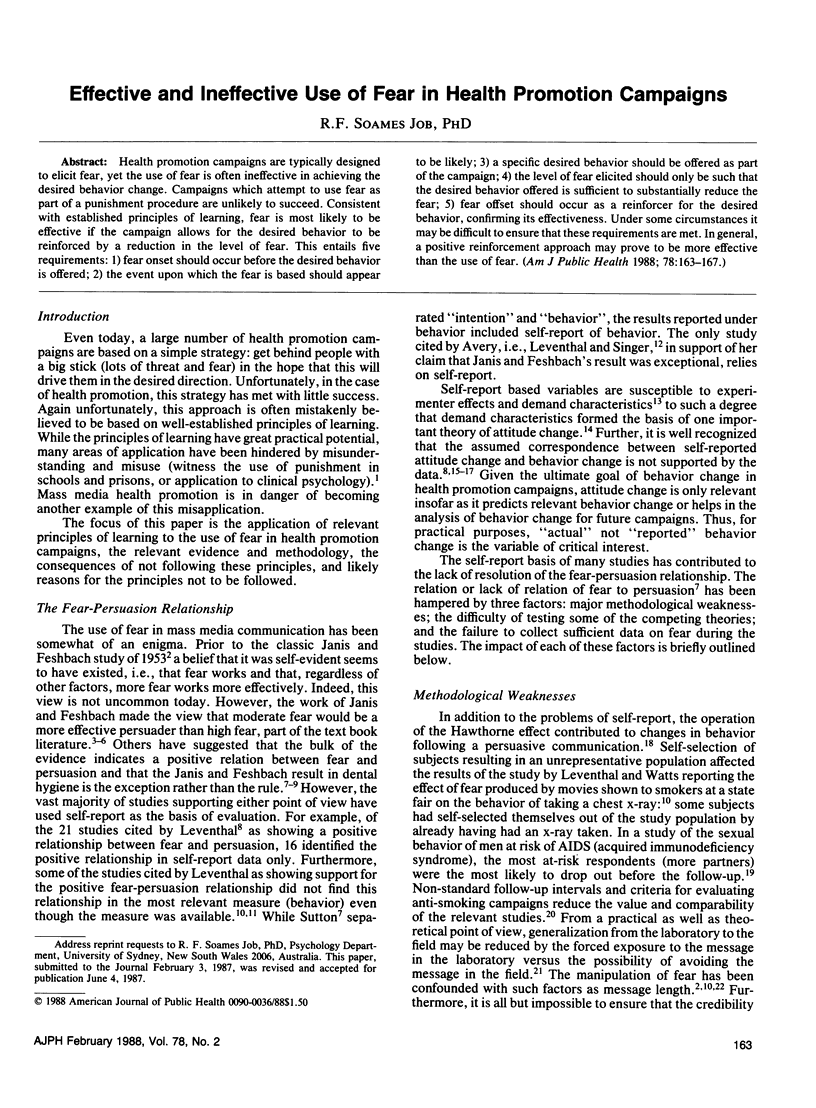
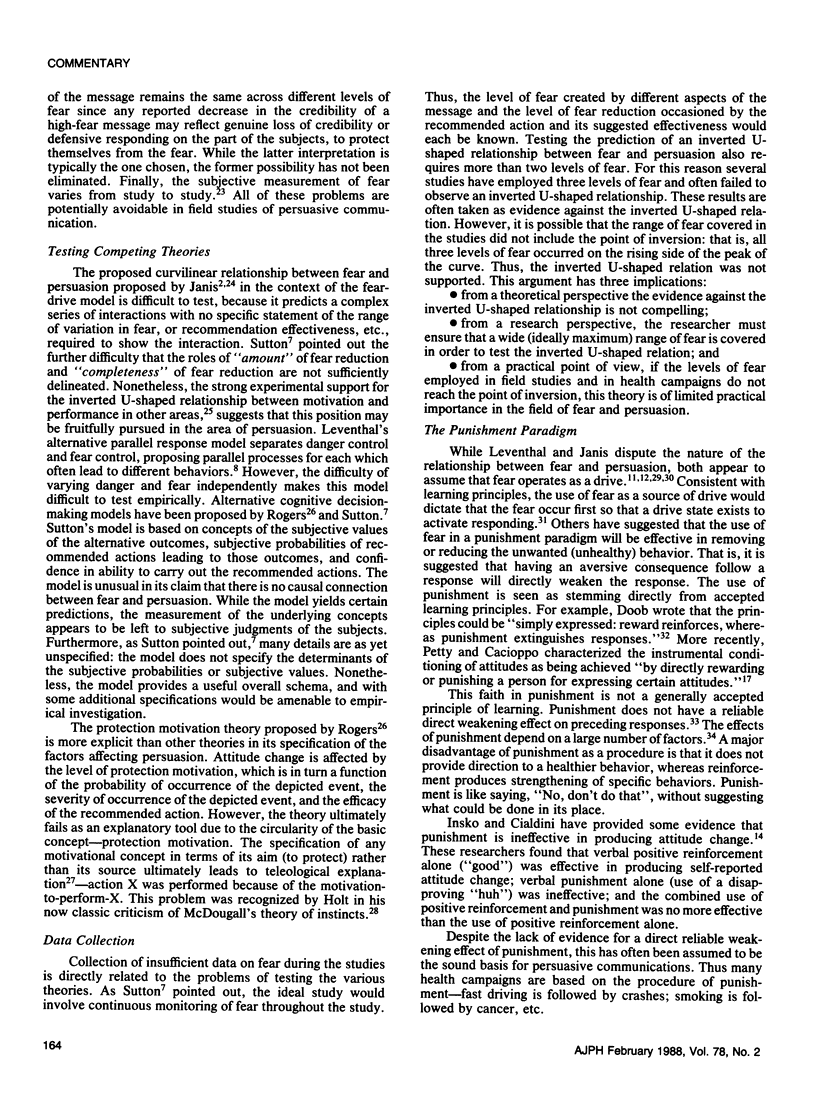
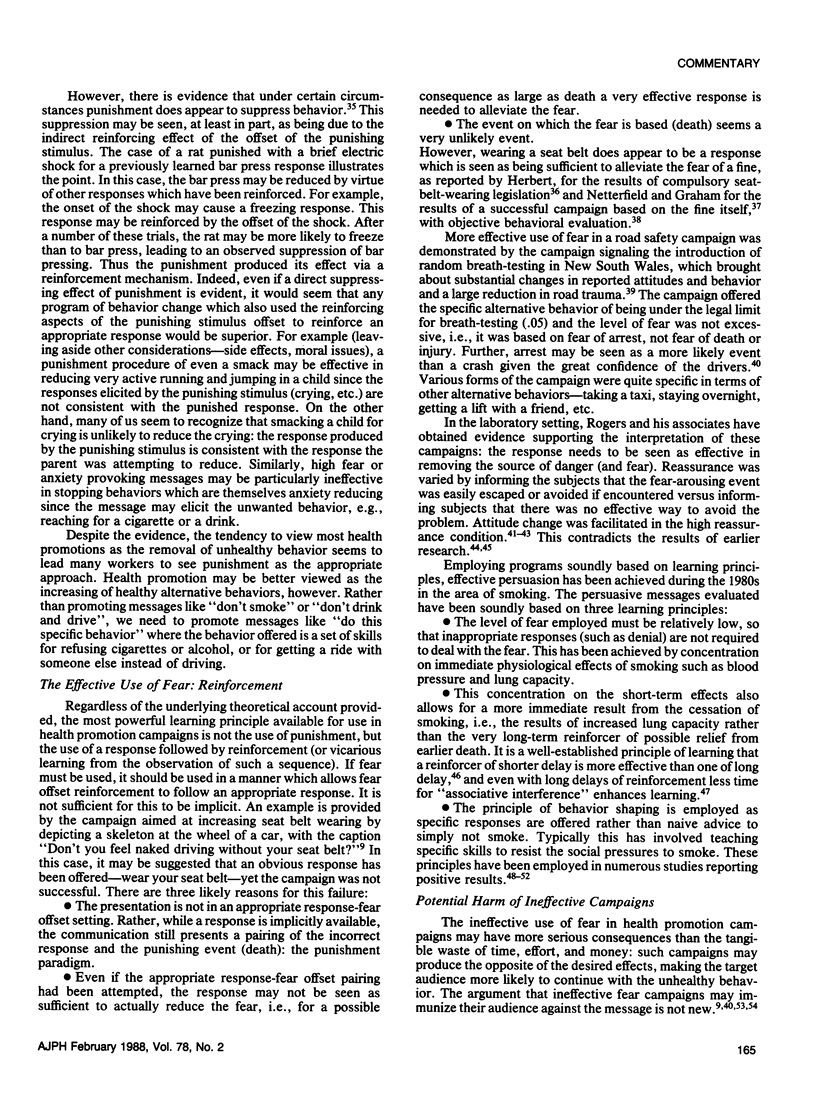
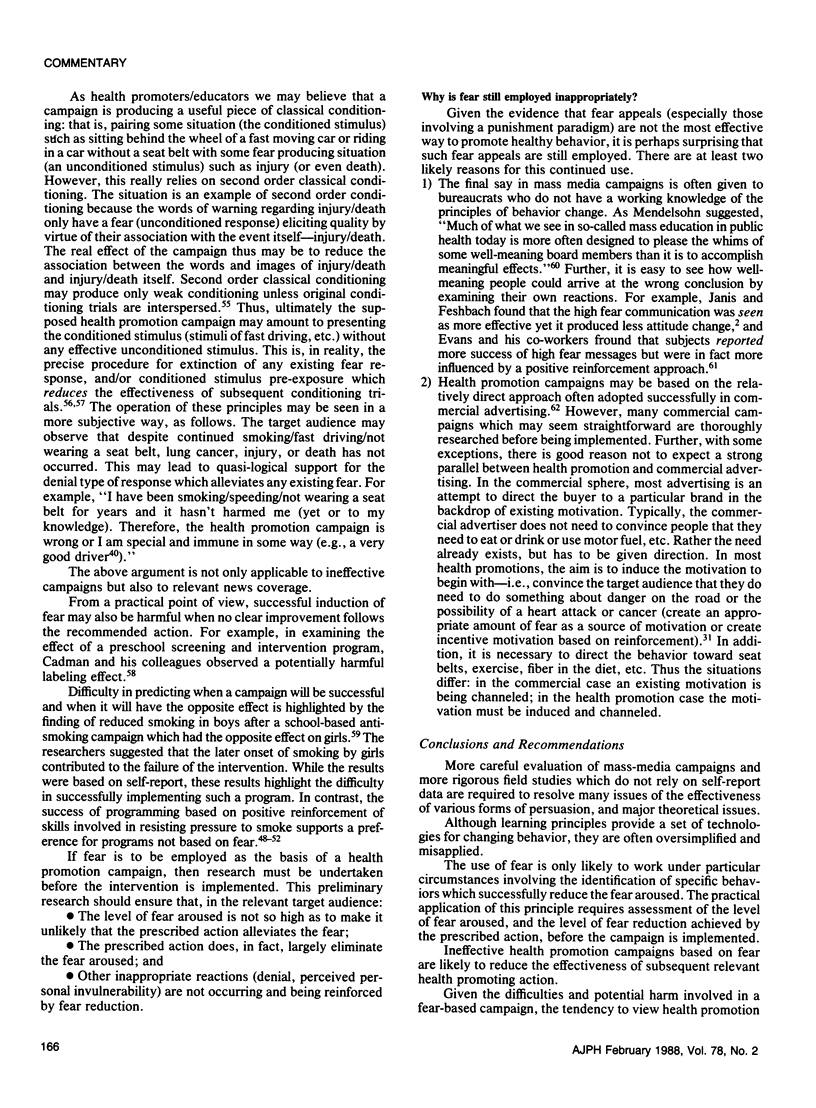
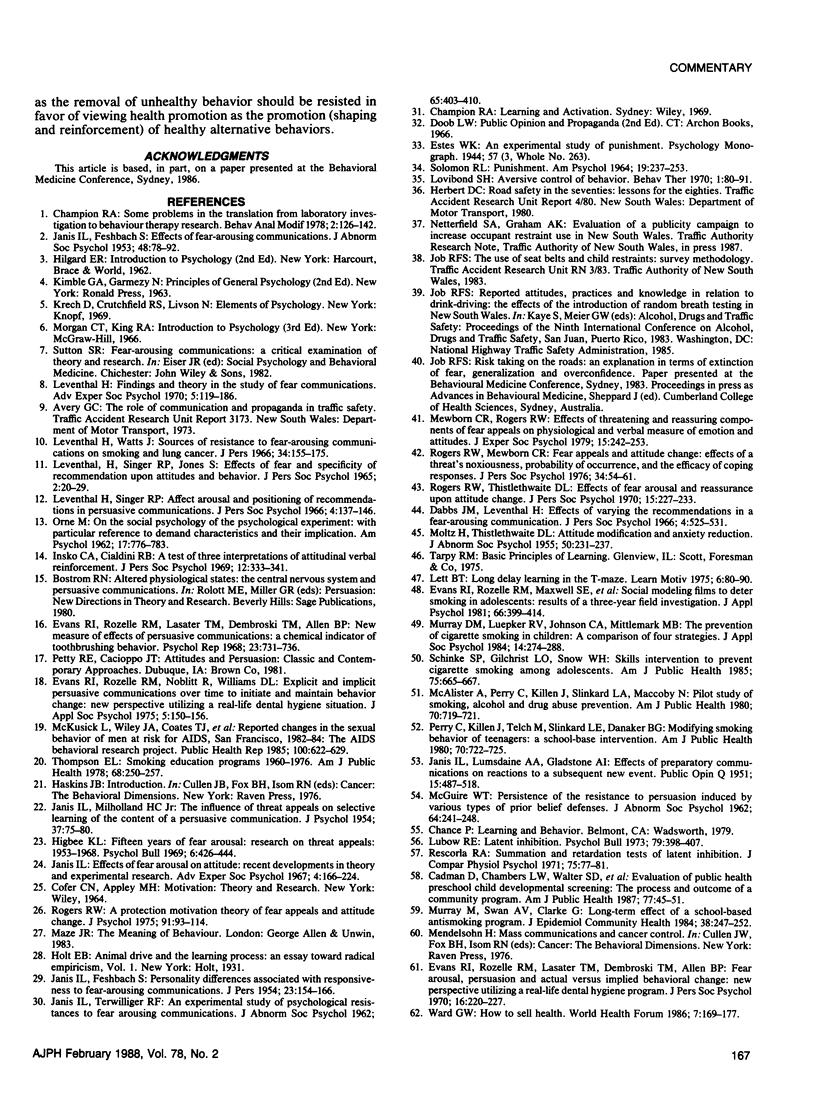
Selected References
These references are in PubMed. This may not be the complete list of references from this article.
- Cadman D., Chambers L. W., Walter S. D., Ferguson R., Johnston N., McNamee J. Evaluation of public health preschool child developmental screening: the process and outcomes of a community program. Am J Public Health. 1987 Jan;77(1):45–51. doi: 10.2105/ajph.77.1.45. [DOI] [PMC free article] [PubMed] [Google Scholar]
- Dabbs J. M., Jr, Leventhal H. Effects of varying the recommendations in a fear-arousing communication. J Pers Soc Psychol. 1966 Nov;4(5):525–531. doi: 10.1037/h0021190. [DOI] [PubMed] [Google Scholar]
- Evans R. I., Rozelle R. M., Lasater T. M., Dembroski T. M., Allen B. P. Fear arousal, persuasion, and actual versus implied behavioral change: new perspective utilizing a real-life dental hygiene program. J Pers Soc Psychol. 1970 Oct;16(2):220–227. doi: 10.1037/h0029834. [DOI] [PubMed] [Google Scholar]
- Evans R. I., Rozelle R. M., Lasater T. M., Dembroski T. M., Allen B. P. New measure of effects of persuasive communications: a chemical indicator of toothbrushing behavior. Psychol Rep. 1968 Dec;23(3):731–736. doi: 10.2466/pr0.1968.23.3.731. [DOI] [PubMed] [Google Scholar]
- Higbee K. L. Fifteen years of fear arousal: research on threat appeals: 1953-1968. Psychol Bull. 1969 Dec;72(6):426–444. doi: 10.1037/h0028430. [DOI] [PubMed] [Google Scholar]
- JANIS I. L., FESHBACH S. Effect of fear-arousing communications. J Abnorm Psychol. 1953 Jan;48(1):78–92. doi: 10.1037/h0060732. [DOI] [PubMed] [Google Scholar]
- JANIS I. L., FESHBACH S. Personality differences associated with responsiveness to fear-arousing communications. J Pers. 1954 Dec;23(2):154–166. doi: 10.1111/j.1467-6494.1954.tb01145.x. [DOI] [PubMed] [Google Scholar]
- JANIS I. L., TERWILLIGER R. F. An experimental study of psychological resistance to fear-arousing communications. J Abnorm Soc Psychol. 1962 Dec;65:403–410. doi: 10.1037/h0047601. [DOI] [PubMed] [Google Scholar]
- LEVENTHAL H., SINGER R., JONES S. EFFECTS OF FEAR AND SPECIFICITY OF RECOMMENDATION UPON ATTITUDES AND BEHAVIOR. J Pers Soc Psychol. 1965 Jul;2:20–29. doi: 10.1037/h0022089. [DOI] [PubMed] [Google Scholar]
- Leventhal H., Watts J. C. Sources of resistance to fear-arousing communications on smoking and lung cancer. J Pers. 1966 Jun;34(2):155–175. doi: 10.1111/j.1467-6494.1966.tb01706.x. [DOI] [PubMed] [Google Scholar]
- Lubow R. E. Latent inhibition. Psychol Bull. 1973 Jun;79(6):398–407. doi: 10.1037/h0034425. [DOI] [PubMed] [Google Scholar]
- MOLTZ H., THISTLETHWAITE D. L. Attitude modification and anxiety reduction. J Abnorm Psychol. 1955 Mar;50(2):231–237. doi: 10.1037/h0042179. [DOI] [PubMed] [Google Scholar]
- McAlister A., Perry C., Killen J., Slinkard L. A., Maccoby N. Pilot study of smoking, alcohol and drug abuse prevention. Am J Public Health. 1980 Jul;70(7):719–721. doi: 10.2105/ajph.70.7.719. [DOI] [PMC free article] [PubMed] [Google Scholar]
- McKusick L., Wiley J. A., Coates T. J., Stall R., Saika G., Morin S., Charles K., Horstman W., Conant M. A. Reported changes in the sexual behavior of men at risk for AIDS, San Francisco, 1982-84--the AIDS Behavioral Research Project. Public Health Rep. 1985 Nov-Dec;100(6):622–629. [PMC free article] [PubMed] [Google Scholar]
- Murray M., Swan A. V., Clarke G. Long term effect of a school based antismoking programme. J Epidemiol Community Health. 1984 Sep;38(3):247–252. doi: 10.1136/jech.38.3.247. [DOI] [PMC free article] [PubMed] [Google Scholar]
- Perry C., Killen J., Telch M., Slinkard L. A., Danaher B. G. Modifying smoking behavior of teenagers: a school-based intervention. Am J Public Health. 1980 Jul;70(7):722–725. doi: 10.2105/ajph.70.7.722. [DOI] [PMC free article] [PubMed] [Google Scholar]
- Rescorla R. A. Summation and retardation tests of latent inhibition. J Comp Physiol Psychol. 1971 Apr;75(1):77–81. doi: 10.1037/h0030694. [DOI] [PubMed] [Google Scholar]
- Rogers R. W., Mewborn C. R. Fear appeals and attitude change: effects of a threat's noxiousness, probability of occurrence, and the efficacy of coping responses. J Pers Soc Psychol. 1976 Jul;34(1):54–61. doi: 10.1037//0022-3514.34.1.54. [DOI] [PubMed] [Google Scholar]
- Rogers R. W., Thistlethwaite D. L. Effects of fear arousal andreassurance on attitude change. J Pers Soc Psychol. 1970 Jul;15(3):227–233. doi: 10.1037/h0029437. [DOI] [PubMed] [Google Scholar]
- Schinke S. P., Gilchrist L. D., Snow W. H. Skills intervention to prevent cigarette smoking among adolescents. Am J Public Health. 1985 Jun;75(6):665–667. doi: 10.2105/ajph.75.6.665. [DOI] [PMC free article] [PubMed] [Google Scholar]
- Thompson E. L. Smoking education programs 1960-1976. Am J Public Health. 1978 Mar;68(3):250–257. doi: 10.2105/ajph.68.3.250. [DOI] [PMC free article] [PubMed] [Google Scholar]


